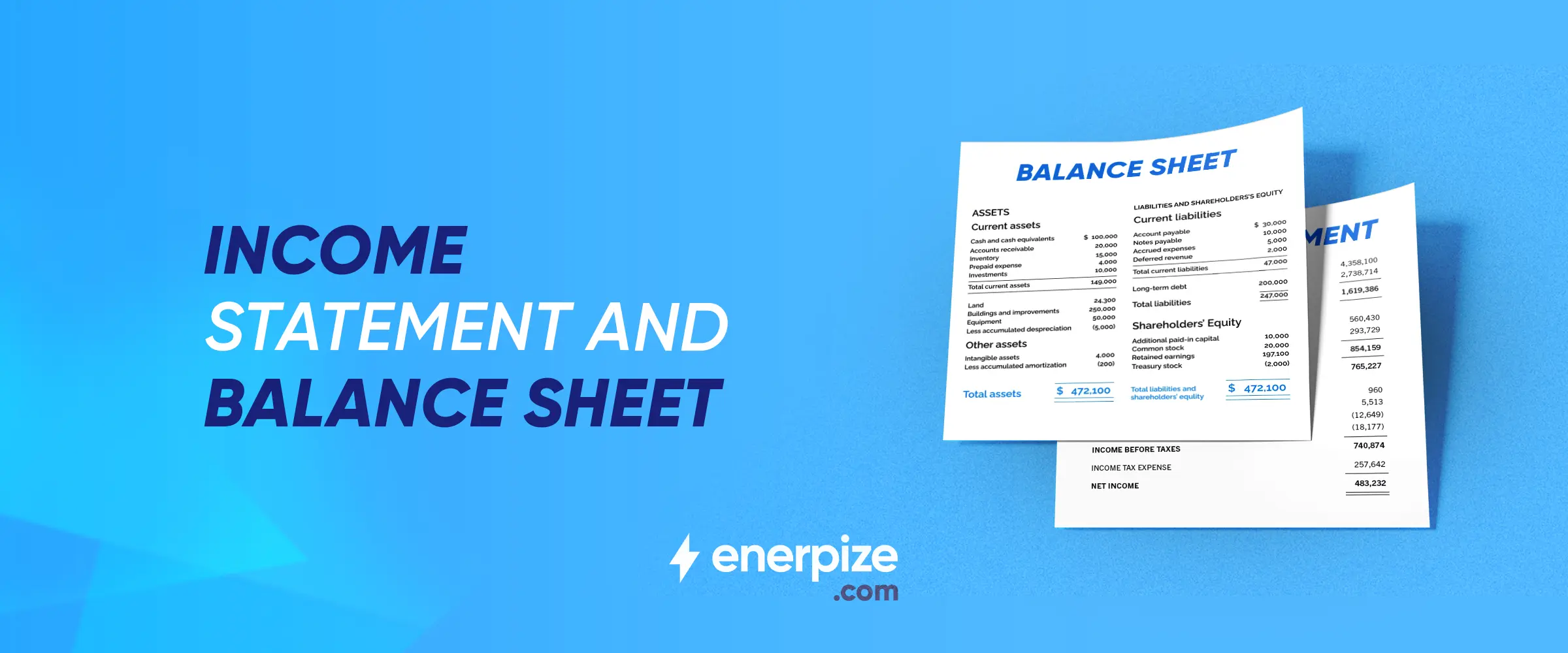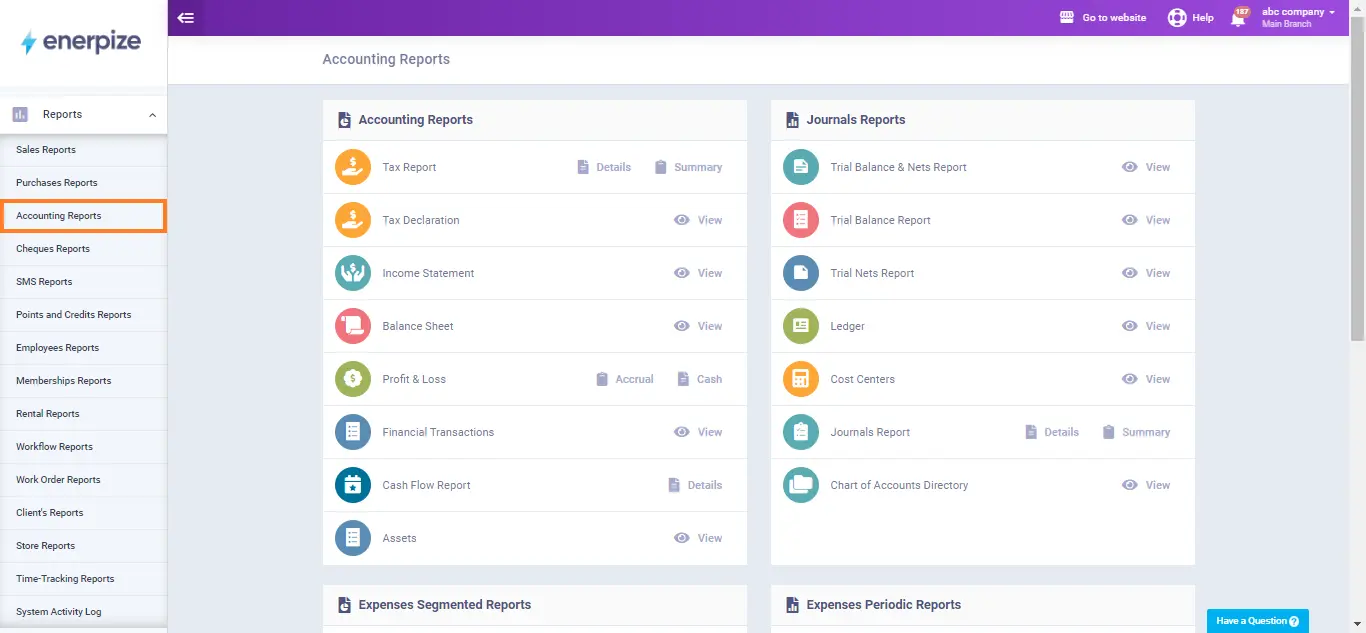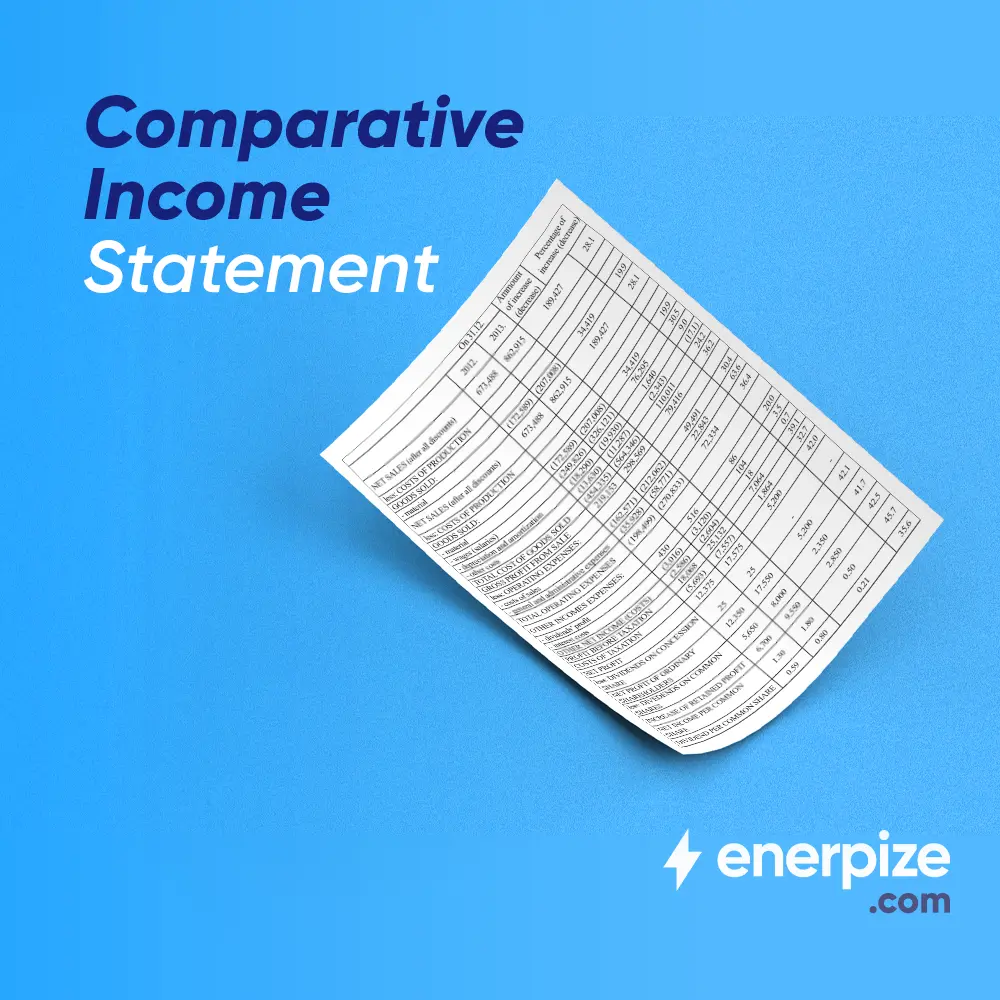Author : Haya Assem
Reviewed By : Enerpize Team
Main Differences Between Income Statement and Balance Sheet

When assessing a company's financial health, the Income Statement and Balance Sheet are two of the most important financial statements. While both provide valuable insights on various aspects of a business, they serve different purposes.
The Income Statement reflects a company's performance over a certain period, highlighting revenues and expenses, while the Balance Sheet provides a comprehensive overview of the company's financial status at a certain period, involving assets, liabilities, and equity.
Understanding the main differences between these statements is critical for making informed financial decisions and determining a company's financial position.
Key Takeaways
- The income statement shows a company’s revenues, expenses, and profits over a set period. The balance sheet, on the other hand, lists assets, liabilities, and equity at a specific point in time.
- The income statement tracks profits, controls expenses, calculates taxes, and helps shape strategy. It shows if the business is making money and how it performs over time.
- Key items include revenue, cost of goods sold, gross profit, operating expenses, and net income. These show how efficiently and profitably the business runs.
- The balance sheet outlines assets, liabilities, and equity. It helps assess liquidity, stability, and shareholder value at a given moment.
- The income statement shows profit over time, while the balance sheet reflects financial health at a point. Together, they offer a full financial overview.
- Both statements support trend analysis, ratios, and resource use. They help businesses evaluate performance and plan ahead.
What is an Income Statement?
An Income Statement, also known as a Profit and Loss Statement, is one of the most important financial statements that clarifies a business’s financial position. It summarizes a company's revenues, expenses, and profits or losses over a specific period (such as a quarter or a year). It provides insight into the company's financial performance by showing whether the business is making a profit or incurring a loss.
Purposes of Income Statement
- Tracking Business Performance: It enables management, investors, and other stakeholders to track financial development and make sound decisions over time.
- Expense Management: By breaking down costs and expenses, businesses can identify areas where they can reduce spending or improve efficiency.
- Tax Calculation: By showing a company's net income, taxable income can be determined. It also identifies deductible expenses, tracks taxable revenue, and offers insight into profits or losses, ensuring accurate tax reporting and compliance.
- Profitability Evaluation: It compares revenues and expenses and shows whether the company is making a profit or loss.
- Strategic Planning: Companies can use past income statements to create budgets and forecasts, predict future performance, and set financial goals.
Income Statement Items
An income statement generally contains various financial items such as revenue, operating expenses, and net income. However, not all businesses report every item in the same way, as details vary based on the business's structure and industry. Some companies may leave out certain details or combine categories, so understanding how these items are presented for accurate financial analysis is essential.
The items below are the most common income statement items:
- Revenue (Sales): The total income generated from business activities, such as selling products or services.
- Cost of Goods Sold (COGS): The direct costs associated with producing goods or services sold, like raw materials and labor.
- Gross Profit: Calculated as Revenue - COGS, it shows the profit before operating expenses.
- Operating Expenses: These include rent, salaries, utilities, and marketing costs necessary for running the business.
- Operating Income: Gross profit - Operating expenses, indicating the profit from core business operations.
- Other Income and Expenses: Non-operating items like interest, investment income, or losses.
- Net Income (Profit): The final profit after all expenses, taxes, and non-operating items are deducted from revenue.
Download Now: Free Profit and Loss Statement Template
What is a Balance Sheet?
A balance sheet is a financial report that gathers a company's assets, liabilities, and equity at a certain time period. It uses the formula:
Assets = Liabilities + Equity.
Assets are everything an organization owns, such as cash, inventory, and accounts receivable; liabilities are everything it owes, such as debts and obligations; and equity is the owners' investment in the company.
This statement provides an overview of how the company's resources are financed through loans or shareholder contributions, which aids in assessing its overall financial health and stability.
Purposes of Balance Sheet
- Financial Position Assessment: Provides an extensive overview of a company's financial situation at a specific period.
- Evaluate liquidity: This Shows the company’s ability to meet short-term obligations by comparing assets and liabilities.
- Determine Stability: Helps stakeholders understand the company’s overall financial health, including its risk exposure.
- Track equity: Displays the owners' investment and retained earnings, indicating the company's value to shareholders.
- Support decision-making: Provides crucial data for investors, creditors, and management to make informed financial decisions.
Balance Sheet Items
The balance sheet consists of the following three key items:
- Assets: Everything a company owns, and they are separated into two types:
- Current Assets: Cash, accounts receivable, inventory, prepaid expenses.
- Non-Current Assets: Property, plant, equipment (PPE), long-term investments, intangible assets (e.g., lands-, trademarks).
Read More: What is the Difference Between Liquid and Illiquid Assets?
- Liabilities: What a company owes, and they are also divided into two types:
- Current Liabilities: Accounts payable, short-term debt, accrued expenses, current portion of long-term debt.
- Non-Current Liabilities: Long-term debt, deferred tax liabilities, pension obligations.
- Equity: This is the residual interest in the company’s assets after deducting all liabilities.
- Owner's Equity/Shareholder's Equity: Common stock, retained earnings, additional paid-in capital, treasury stock.
Read Also: Comparative Balance Sheet: A Comprehensive Guide
Income Statement VS Balance Sheet
Analyzing a business's financial health and stability usually relies on financial statements especially the Income Statement and the Balance Sheet. Each statement serves a distinct purpose and provides valuable insights into different aspects of the company's performance and financial position.
An Income Statement focuses on profitability over a specific period, while a Balance Sheet offers an overview of assets, liabilities, and equity at a certain moment in time.
Understanding the differences between these two statements is essential for stakeholders, including investors, creditors, and management, to make informed financial decisions.
Below is a brief outline that highlights the main differences between a balance sheet and an income statement:
1- Definition
- Income Statement: A financial statement that shows a company’s revenues and expenses over a specific period, resulting in net income or loss.
- Balance Sheet: Financial statement that reflects a company's assets, liabilities, and equity at a certain period.
2- Purpose
- Income Statement: Shows profitability over time.
- Balance Sheet: Provides an overview of the financial situation at a certain point in time.
3- Components
- Income Statement: Revenues, expenses, and net income.
- Balance Sheet: Assets, liabilities, and equity.
4- Timeframe
- Income Statement: Covers a specific period (quarterly, annually).
- Balance Sheet: Represents a single moment in time.
5- Focus
- Income Statement: Measures financial performance.
- Balance Sheet: Assesses financial health and stability.
6- Formula
- Income Statement: Revenues - Expenses = Net Income
- Balance Sheet: Assets = Liabilities + Equity.
7- Benefits
- Income Statement: Helps in evaluating operational efficiency and profitability.
- Balance Sheet: Aids in assessing liquidity and financial stability.
Using Income Statement and Balance Sheet Together
Combining the Income Statement and Balance Sheet accurately depicts a company's financial health. The Income Statement measures profitability, while the Balance Sheet represents assets, liabilities, and equity. They work together to identify trends, generate financial ratios, and guide investment decisions, as detailed below:
1- Comprehensive Analysis:
The Income Statement details revenues and expenses and reveals whether the company is making profits or incurring losses over a specific period. A Balance Sheet depicts what the company owns (assets), what it owes (liabilities), and the owners’ equity at a particular time.
2- Pattern Analysis:
By reviewing both statements across different periods, stakeholders may identify trends in profitability, liquidity, and financial stability. This supports future performance forecasting and making well-informed decisions.
3- Financial ratios:
Key ratios, such as Debt-to-Equity, which divides total liabilities by equity (from the Balance Sheet), evaluate a company's financial situation. Gross Margin, determined by dividing gross profit by total revenues (from the Income Statement), indicates how effectively the business produces goods relative to sales.
4- Resource Management:
By comparing net income to total assets or equity, you can observe how successfully a business uses its resources to generate profits while assessing operational efficiency.
5- Investment Decisions:
Investors and creditors may use both statements to assess the company's performance and risk profile, which can help them make investment and financing decisions.
Read Also: Income Statement VS Cash Flow Statement
How to Calculate Net Income From Balance Sheet?
To calculate net income, you need to gather data from both the balance sheet and the income statement, as the balance sheet does not directly provide it. However, to know how to calculate net income from a balance sheet follow the steps below:
Start by reviewing the equity section of the balance sheet for retained earnings, which is the accumulated net income over time. Next, calculate the difference between the retained earnings of the current period and the previous period.
This difference reflects the net income or net loss for the current period, assuming no dividends were paid out. For an accurate calculation, subtract dividends declared from the change in retained earnings.
Alternatively, net income can usually be calculated using an income statement by deducting total expenses from total revenue. The balance sheet is used to validate this calculation by looking into changes in retained earnings.
Net income formula from balance sheet:
Net Income = Ending Retained Earnings - Beginning Retained Earnings + Dividends Declared
- Ending Retained Earnings: This is found on the current balance sheet.
- Beginning Retained Earnings: This is found on the previous balance sheet.
Dividends Declared: This amount is subtracted if dividends were paid out during the period.
Read Also: How to Calculate Retained Earnings on A Balance Sheet
How Can Enerpize Streamline Financial Statements?
Enerpize streamlines financial statements by automating the whole process, from data entry to report generation, ensuring real-time accuracy and reducing manual errors with just one click.
Our online accounting software includes various business modules such as sales, payroll, and inventory, which combine data to provide comprehensive financial reports such as income statements and balance sheets.
With customizable reporting options, businesses gain tailored insights into their financial health, making it easier to analyze performance and make informed decisions. This automation allows for more efficient, accurate, and timely financial reporting.

Financial statements are easy with Enerpize.
Try our accounting module to track your company's financial health.








